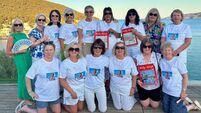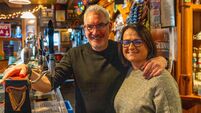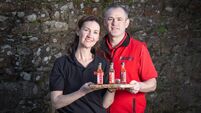In the Garden: A visit to GIY HQ

Lavender-lined pathway to the glasshouse at GIY headquarters
THE garden is looking great and growth is good at present, with plenty of showers to fuel new growth.
The temperatures are good and, provided the soil is in good condition with plenty of organic matter added, then plants will be happy and will carry on flowering or putting on new growth.
Companion planting, particularly with flowers, is such an enjoyable addition to the vegetable garden over the summer months, and it is being executed in a very attractive manner at the GIY (Grow it Yourself) headquarters in Waterford.

Here, nasturtiums and calendula in particular, which compliment GIY’s signature orange pergolas, are located at a number of different areas of the garden, and yellow letter logo colours, which are a new addition since I last visited, provide a fun photo opportunity for visitors.
GIY was founded in 2008 and its headquarters are located at the heart of Waterford city, where there is a zero waste cafe at the hub of operations.
Food production and providing solutions to current problems are what GIY is all about. There is a gift shop, glasshouse, polytunnels and vegetable growing areas, as well as a woodland area beyond.
The cafe prides itself on using many ingredients which only have to travel 112 steps or less to get to the plate. Really, it does not get more farm to fork friendly than that!
Walking around the gardens gives a great insight as to how vegetables are grown, and head grower, Richard Mee, is available to give guided tours at different times of the year. In addition, there are information boards dotted throughout the gardens, giving information about crop rotation, composting, protected growing, and much more.

A Ridan composter is used on-site to deal with cooked and uncooked food waste to create compost for addition to the vegetable beds. There are also lots of other educational courses both online and workshop-based run throughout the year in the 2,000m2 gardens.
A great way to meet like-minded people looking for greener ways of producing food locally and in a more sustainable manner.
We all need to look at our own gardening practices and examine what we can do better, understanding the forces at work in the garden and the huge benefits of retaining some natural habitat so the ecosystem that is our garden can be kept in balance, with natural predators helping to keep it so. By allowing natural predators in, we are also helping them.
It is about understanding how the system works so that we can all benefit from working together.
Many plants grown as companions seed themselves and so automatically reappear year after year where the soil is left undisturbed.
Borage is another great plant for its edible flowers and attracting insect life.
Sunflowers can be used to train climbers up their strong stems and the seeds will feed birds from autumn into winter.
Cosmos provide attractive flowers and add some height to vegetable beds, as well as bringing beneficial insects in.
The umbellifer family are undoubtedly some of the best for bringing in the insects to the garden, and I just love the frothy effect of the flowers.
Lacewings, ladybirds, hoverflies and soldier beetles are all commonly seen feeding on the flattened flowers of umbellifers like carrots, yarrow, fennel, parsley and cow parsley. The nectar is very accessible from the flowers of umbellifers, making them a good option for a quick snack.
This year, I have decided to designate a corner of the polytunnel to flowering and seed production where the curly leafed or moss parsley is growing.
Parsley is a biennial that we generally grow as an annual as it is the fresh new leaves that are used for cooking. It started running to seed last year in its second year and it was left to set seed and new plants emerged in that corner.
This year, there are many plants which have been left to flower and now that corner is a haven for hover flies which rise up out of the flowers/seed heads when the water hose arrives!
The benefit for the polytunnel is in evidence with little greenfly to report on lettuce this year and the temperatures were high early in the year.
This ‘wild area’, which evolved itself, is worth gold for the overall health and management of the polytunnel, and it is worth the sacrifice of a little growing space for the benefits provided.
There was the added benefit of having fresh parsley earlier in the year until the plants ran to seed, eventually there will be one and two year old parsley growing together which will make it a productive corner in time!

Plant of the Week
Borage (below) is a great self-seeder in the garden and its blue star-shaped flowers provide a healthy, tasty treat while working in the garden.
The leaves are quite coarse and prickly to the touch and the roots are shallow and fibrous, making them easy to whip out.
Borago officinalis is an annual plant native to the Mediterranean and has naturalised here, emerging on soil in disused areas.
It can be used in a wildflower seed mix but it will frequently dominate the mix after a year or two.
It will do best in full sun on a free draining soil and can get to a height of about two metres, so it can dominate quite quickly.
It is easily removed and assigned to the compost heap, but choose your area for planting carefully to avoid creating work!







 App?
App?


